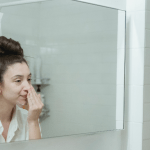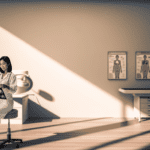1 in 8 women will be diagnosed with breast cancer at some point in their lives.
85% of breast cancers nowadays occur in women with no family history of breast cancer.
There are two chemicals that have become prevalent in both conventional personal care and household products and also in the environment that are linked to breast cancer: parabens and phthalates.
Here, we’re going to be looking at phthalates.
Evidence links several specific phthalates to breast cancer and other negative health effects.
What exactly are they?
Phthalates are known as the “everywhere” chemical. They are a class of chemicals used to make plastics soft, flexible and stable. Some phthalates are used as solvents and stabilizers in product formulations
You can find phthalates in many consumer products, including: nail polish, fragrances, plastics, building materials, cleaning products, insecticides, pharmaceuticals, food packaging, home decor, children’s toys, and personal care products. Phthalates are also used in pharmaceutical capsules to impart delayed- or extended-release properties
Phthalates are ubiquitous in our environment and very hard to avoid.

So, there are two major groups of phthalates.
The first group contains chemicals that are found in numerous plastics and PVC-based products including:
- Shower curtains, vinyl floors, PVC mini-blinds, furniture, soft-sided lunch boxes, plastic food wrap and packaging, soft plastic food containers, and medical devices such as intravenous (IV) bags and tubing
Phthalates found in this group include:
- Di(2-ethylhexyl) phthalate (DEHP) and its main metabolites (breakdown products) mono-ethylhexyl phthalate (MEHP), mono-ethyl-5-hydroxyhexyl) phthalate (MEHHP)
- Di-n-octyl phthalate (DnOP) and its major metabolite mono-(3-carboxypropyl) phthalate (MCPP)
- Diisononyl phthalate (DiNP)
The second group of phthalates are found in solvents, and a number of your everyday products including:
- Cosmetics and personal care products, tampons and other feminine hygiene products, fragrances in perfumes, personal care products, and many household products, hair spray, nail polish, air fresheners (plug-ins, sprays, and reed diffusers), adhesives, and paints

Examples of this second group of phthalates compounds include:
- Diethyl phthalate (DEP) and its major metabolite mono-ethyl phthalate (MEP)
- Dimethyl phthalate (DMP) and its major metabolite mono-methyl phthalate (MMP)
- Dibutyl phthalate (DBP) and its major metabolite mono-n-butyl phthalate (MBP)
- Diisobutyl phthalate (DiBP) and its major metabolite mono isobutyl phthalate (MiBP)
- Benzylbutyl phthalate (BzBP) and its major metabolite mono-benzyl butyl phthalate (MBzP)
You can be exposed to phthalates by inhalation, ingestion, intravenous absorption (resulting from medical injection procedures) and skin absorption.
Phthalates are endocrine disruptors which means they can disrupt several hormonal systems in the human body, including the estrogen, progesterone and androgen systems.
Phthalates can induce proliferation, migration, invasion, and tumor formation of estrogen receptor negative breast cancers. What’s interesting about that is that it shows that they have negative health consequences beyond their ability to disrupt hormones.
Phthalate metabolites (the compounds that our bodies turn them into before they are excreted) in the urine are linked to an increased risk of both breast cancer and uterine fibroids.
Phthalates are linked to early breast development in girls, which increases the risk of breast cancer and other diseases.
In a study from Mexico, exposures to higher levels of DEP and its metabolite were associated with increased risk for developing breast cancer, especially in premenopausal women.
BzBP and DBP have been shown to cause cell proliferation, tumor formation, and malignant invasion of breast cancer cells that are low in or lack hormone receptors, indicating that there are negative health effects of phthalates beyond their direct impact on the estrogen-regulated systems.
Women have higher exposures to phthalates than men; however, because phthalates have become ubiquitous in our environment, used now in everything from personal care products to industrial adhesives and building materials, everyone is equally at risk for exposure. Men are also at risk for breast cancer.
Exposure to BzBP, DBP, DEHP and DMP is highest in children ages 6 to 11.
Exposure to DEP, used as a solvent in many products containing fragrance (e.g., perfume, deodorant, soaps and shampoos) is typically highest in men and women age 20 years and older, followed closely by 12- to 19-year-olds.
Fetuses and infants, who are at critical stages of development, are particularly sensitive to phthalate exposure.
Phthalates can cross the placenta and are present in and can be transmitted through breast milk, it is important that women of child-bearing age, pregnant women and mothers who are breast-feeding avoid phthalate exposure.

What can you do to avoid phthalates?
Avoid plastics for food prep and storage: Food containers made from PVC plastics (i.e., number 3 plastics) contain phthalates, as do vinyl plastic cooking utensils, plastic food storage containers and plastic food packaging
Use glass, ceramic or metal for storage and preparation of hot foods. Avoid hot foods packaged in plastic. Microwave in glass or ceramic, never in plastic.
Choose natural materials for your home. Avoid vinyl shower curtains, vinyl flooring, plastic window treatments, and vinyl replacement windows.
Become a label reader: Avoid buying personal care products that contain “fragrance” or “perfume.” Choose nail polish that is phthalate free and bring your own polish to the nail salon if they don’t offer a phthalate-free option. These are typically labeled “DBP-free” or “Toxic Trio Free.”
Avoid perfumes, fragrances and air fresheners. FDA regulations do not require companies to list fragrance components on ingredient labels, because fragrance formulations are considered proprietary. Phthalates (especially DEP) are often added to fragrance to make the scent linger. As a result, fragrances, perfumes and scented lotions, soaps and other products can contain phthalates. Avoid using artificial air fresheners such as plug-ins, sprays or artificially scented candles.
Switch to safe, 100% all natural products, water-free and chemical free. They don’t contain phthalates. Only water-free skin care products can be chemical-free. So the quick thing is to check the labels just for water.







